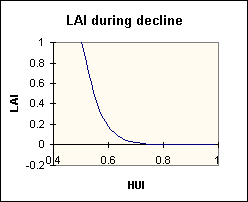Garden with Insight
Product area
Help System
Contents
Quick start
Tutorial
How-to
Models
|
Garden with Insight v1.0 Help: Plant next day functions: calculate leaf area index
Leaf area index (LAI) is simulated using a fairly simple function based
on the heat unit index and on parameters that describe the shape of the LAI curve. The curve is divided
into two sections: before the start of leaf area decline due to senescence,
and after the start of decline. The heat unit index when decline starts is a plant parameter.
Before leaf area decline starts, LAI follows an S curve with the heat
unit index as the Y value. Parameters that define the LAI S curve are
important plant parameters. For annual plants, normally the curve is
adjusted so that the plant nearly reaches its maximum LAI (a parameter) at a heat unit index of 0.5, or
halfway to maturity. This makes sense because plants try to get their vegetative growth taken care of
before they turn their attention to reproduction. For perennials the
curve is less steep. Finally, the actual leaf area index before decline is reduced by the square of the
combined general biomass growth constraint. Since this constraint has
not yet been calculated for today's growth, yesterday's growth constraint
is used.
After the start of LAI decline, the leaf area index is calculated using a logarithmic decline from the LAI at
its peak to zero at HUI = 1.0. The rapidity of decline is determined by a plant parameter. In the declining
phase there is no adjustment to LAI from plant stresses. However, an adjustment to new growth is made based on the daily decline in LAI to account for decreasing photosynthesis due to
declining leaf area.

Leaf area index, heat unit index, and plant growth play off on each other in this way in a few such places
in the simulation. You could say that the model might be simpler if the
heat unit index, the leaf area index, and the plant biomass were all
combined into the same indicator of growth. For example, if one modeled the growth of individual leaves
it would give you both leaf area index and biomass, and heat unit index might not be needed. This is
possible. However, any addition to the complexity of a model (and its closeness to reality) requires the
addition of more parameters for which data must be collected and for which the model must be tested.
calculation of heat unit index, combined
general biomass growth constraint
EPIC Leaf Area Index
Model contents
|

